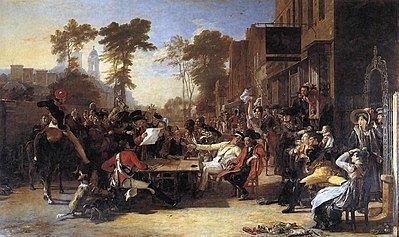Artist David Wilkie Created 1822 Period Romanticism | Dimensions 95 cm x 1.58 m Media Oil paint | |
 | ||
Genres Genre art, History painting Similar David Wilkie artwork, Oil paintings | ||
The Chelsea Pensioners reading the Waterloo Dispatch, originally entitled Chelsea Pensioners Receiving the London Gazette Extraordinary of Thursday, June 22, 1815, Announcing the Battle of Waterloo, is an oil painting by David Wilkie, commissioned by Arthur Wellesley, 1st Duke of Wellington in August 1816.
Contents
It was exhibited at the Royal Academy summer exhibition in 1822, where it was so popular that a rail was installed to protect it from the thronging crowds. This was the first time that a rail was needed at the Royal Academy exhibition.
Background
Wellington was introduced to Wilkie by Thomas Graham, 1st Baron Lynedoch in August 1816, the year after the Battle of Waterloo. Wellington commissioned Wilkie, who intended to complete the work within two years. Willkie specialised in genre painting, but in this work he attempted to combine genre painting with history painting. The painting took the relatively novel approach of showing history in a contemporary setting, without adding references to ancient history or the Bible.
Wilkie prepared a sketch, but it was not viewed by the Duke until March 1819, when he asked for some changes to add more and younger soldiers. The work was not completed until 1822. After its successful first exhibition, Wilkie asked the Duke for an exceptionally large fee of 1,200 guineas.
Description and characters
The painting measures 158 × 97 centimetres (62 × 38 in). It shows old soldiers gathered around a wooden table outside the "Duke of York" public house, in Jew's Row off the King's Road in Chelsea. The Royal Hospital Chelsea is visible in the background to the left.
One of the soldiers is reading the "Waterloo Gazette", which published the Waterloo Dispatch sent by the Duke of Wellington immediately after the Battle of Waterloo on 18 June 1815. The dispatch, dated 19 June 1815, was reprinted in several editions of the London Gazette on 22 June 1815.
The painting includes many portraits of characters identified in notes prepared by Wilkie, and include, from left to right:
In the background, a Highlander is playing the bagpipes.
Reception
The painting's focus on ordinary people made a significant impression on Théodore Géricault when he viewed the unfinished work in Wilkie's studio in the spring of 1821, and on its second showing at the Royal Institution. It was also seen by Eugène Delacroix and Richard Parkes Bonington.
The painting was given a prominent, central position at the Royal Academy summer exhibition at Somerset House in 1822, hanging over the fireplace beside a portrait of the Duke of Wellington by Sir Thomas Lawrence. It became so popular that a rail was installed to protect it from the crowds, the first time that this precaution had been needed at a Royal Academy exhibition (the next occasion was for William Powell Frith's The Derby Day in 1858).
Wilkie received his commission of 1,200 guineas from Wellington, and he was paid a further 1,200 guineas by the publishers Graves & Co for the right to reproduce the painting as an print, engraved by John Burnet in 1829. The publisher also commissioned a watercolour copy, sold at Sotheby's in London on 14 April 1994.
Wilkie's preparatory drawings show the evolution of the group. There are also several oil sketches, including one at the Yale Center for British Art, c.1819.
The painting was retained by the Duke of Wellington and his descendants, and it is displayed at Apsley House.
